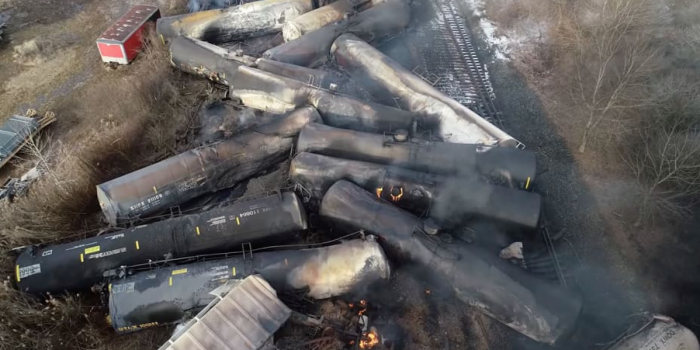Concerns about public health and the environment have grown in East Palestine, Ohio, following the release of hazardous fumes from multiple derailed train cars last week.
A train carrying hazardous chemicals partially derailed and caught fire in eastern Ohio on February 3, spewing thick black smoke into the air. The state governor ordered the evacuation of over 1000 persons in the town of East Palestine and adjacent areas.
The evacuation order was lifted on February 8, and there have been several complaints of people having a burning sensation in their eyes, animals being unwell, and a pungent scent lingering around the town since then.

On February 12, the EPA issued a list of dangerous compounds found in the derailed trains, compiled by Norfolk Southern. The derailment affected approximately 50 of the train’s 150 cars, according to the US Environmental Protection Agency (EPA); 20 cars on the train were listed as containing hazardous materials, including several containing vinyl chloride, butyl acrylate, and ethylhexyl acrylate, according to the letter sent to Norfolk Southern Railway, the company that operated the train.
Vinyl chloride is the most harmful, and persistent exposure can cause liver damage. In addition, it can cause dizziness, sleepiness, and headaches at high doses. According to the EPA website, certain substances may emit an odor at concentrations below permissible limits.

Norfolk Southern contractors constructed a dam at the site to collect toxic water. They also used a vacuum truck and absorbent pads to contain spilled chemicals.
Due to worries about a massive explosion, an EPA team conducted a “controlled burn” of vinyl chloride from five cars on FeFebruary 6diverting the chemical into a trench and burning it off. When vinyl chloride is burned, it produces phosgene and hydrogen chloride, both harmful to humans at high doses.
The burn produced a gigantic fireball and column of black smoke over the location, photographs of which sparked the social media hashtag #OhioChernobyl.
According to the EPA, air quality testing in East Palestine did not find pollutants of concern in the days following the incident or following the controlled fire.
Volatile organic compound levels, including vinyl chloride and butyl acrylate, have maintained below levels considered detrimental to human health by the EPA, while the particulate matter was measured above permissible levels following the derailment and controlled fire.
The EPA is still monitoring air quality in East Palestine and inspecting individual residences near the derailment as part of a “re-entry” screening process.

As of February 13, no vinyl or hydrogen chloride had been detected in schools, the town library, or 291 houses. There were 181 residences that had not yet been screened.
According to the EPA website, the East Palestine Water Treatment Plant was unaffected the day following the disaster. Water treatment operators downstream on the Ohio River also stated that they had noticed no changes in the river at their intake but were taking cautious measures, such as establishing a separate intake on a different river.

The Ohio environmental agency and a contractor hired by the railroad corporation have also examined soil at the derailment site and water in nearby waterways.
However, until the laboratory results from those samples are available, state officials have encouraged residents with private wells to use bottled water.


